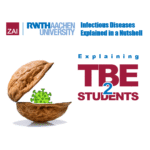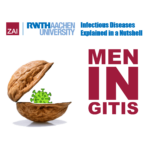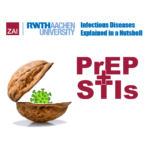Schlagwort: ‘STI testing’
Let’s have a Prep-Talk about Sex…
—
…ually Transmitted Infections
Disclaimer!
This article and its major media content are produced by students to train science communication as part of a lecture about human infectious pathogens. The article does not represent official advice from the authorities. For authorized information about the disease in question, please refer to the official health authorities in your country or the World Health Organization.
By Stamatis Spyridonidis and Veera Kostamo
Over the past few years, remarkable progress has been made in the field of sexually transmitted infections (STIs), particularly in the realm of prevention strategies. One approach that has gained significant attention since 2012 is Pre-Exposure Prophylaxis (PrEP). By utilising antiretroviral medication, PrEP effectively reduces the risk of acquiring HIV. However, it is crucial to consider the interconnectedness of HIV and other STIs when addressing sexual health. While the approval of PrEP has led to a decrease in HIV cases, there has been a noticeable rise in several other STIs. The question arises: why is this happening?
Understanding HIV and other Sexually Transmitted Infections (STIs)
The Human Immunodeficiency Virus (HIV) is a viral infection that targets the body’s T-cells, essential components of the immune system responsible for safeguarding against diseases. It is transmitted through specific bodily fluids such as blood, semen, vaginal fluids, and breast milk. Once inside the body, the virus replicates rapidly, gradually depleting T-cells. As the immune system weakens, individuals become more vulnerable to various infections and diseases. If it stays untreated, HIV can progress to the acquired immunodeficiency syndrome (AIDS), which currently has no effective cure. However, with proper treatment, including antiretroviral therapy (ART), people living with HIV can lead healthy lives and reduce the risk of transmitting the virus to others.
In addition to HIV, there are various other STIs that primarily spread through sexual contact, blood, or semen, causing a variety of symptoms ranging from discomfort to severe health problems. These infections can be caused by bacteria, viruses, parasites, or fungi. Examples include chlamydia, gonorrhoea, human papillomavirus (HPV), and herpes.
Understanding Numbers and Correlations: Unravelling the Relationship Between STIs and PrEP
The prevalence of four curable STIs—syphilis, gonorrhoea, chlamydia, and trichomoniasis—reached an estimated 374 million incident cases in 2020. Surprisingly, several studies have revealed that individuals using PrEP, a medication to prevent HIV transmission, experienced a higher burden of STIs after initiating the treatment. A comprehensive study done in Montreal, Cananda, spanning five years until 2015 found that the number of STI cases rose from 49 to 84 per 100 persons in the year following PrEP prescription. Although PrEP has proven highly effective against HIV, it does not provide protection against other sexually transmitted infections. The exact correlation between the rising numbers of STIs among PrEP users is still unknown. Various factors play a significant role in this trend, as mentioned in an opinion article by Dr T. Pallidum, a specialist working in the field of STIs. Whether it is a result of engaging in condomless sex, having multiple sexual partners, or adopting riskier sexual behaviours, the key is to develop new strategies to combat these infections.
Implementing Effective Strategies
In response to the rising numbers of STIs, the World Health Organization (WHO) released a new Implementation tool during the 23rd World Congress of the International Union against Sexually Transmitted Infections (IUSTI) in 2022. One crucial aspect emphasised in this implementation tool is the integration of various STI services, such as consultations and STI testing, alongside PrEP prescriptions. Regular trimonthly testing for STIs, combined with the use of PrEP medication, ensures the early detection of asymptomatic infections. Treating these infections promptly helps prevent further transmission to sexual partners.
Accessible STI Testing Centres
In every city, multiple STI testing centres can be found, offering tests for a variety of STIs either free of charge or at a minimal cost. The best part is that testing for STIs is easy, fast, and accessible. All testing centres adhere to the same principles, ensuring reliable and accurate results. To learn more about the testing process, you can refer to the video below:
—
Addressing Sexual Behaviours and Youth: Fostering Open Dialogue
Adolescents and young adults represent one of the most sexually active and risk-taking groups. As they navigate their sexuality, especially in the era of online dating, they often make choices and take risks that can put them in danger. Furthermore, due to the stigma surrounding discussions about sex, young individuals may feel hesitant to ask questions about safe practices and sexual health. To protect them, it is crucial to address the stigma surrounding sex starting from home. Parents should engage in open conversations and provide education to their children about sex, thereby removing the fear associated with discussing these topics.
Dr. Daniel Beer, a specialist in internal medicine and infectiology, shares his perspective on this topic and provides insights into how parents can help address this issue in the following interview:
While PrEP has made significant strides in reducing HIV cases, the rise of other STIs among PrEP users must be addressed. By implementing new strategies that integrate STI services with PrEP prescriptions, advocating for regular testing, and fostering open discussions about sex and safety, we can effectively combat the spread of STIs. It is important for individuals to prioritise their sexual health by taking advantage of easily accessible testing centres and staying informed about the latest advancements in STI prevention.
References:
https://doi.org/10.1007/s10461-018-2252-9
https://doi.org/10.1007/s11904-019-00446-5






